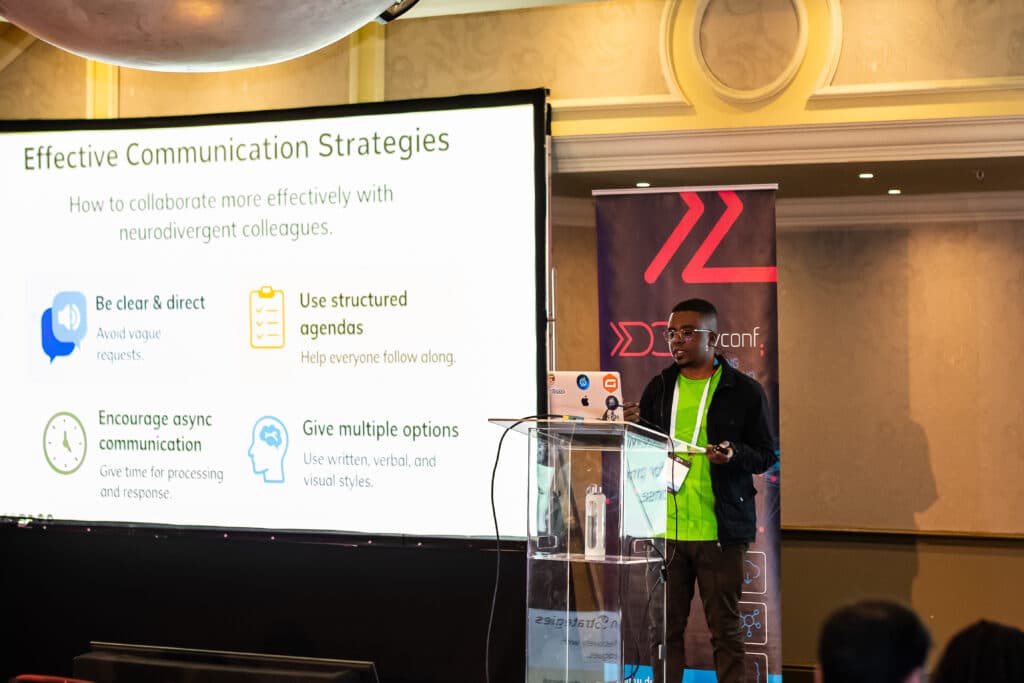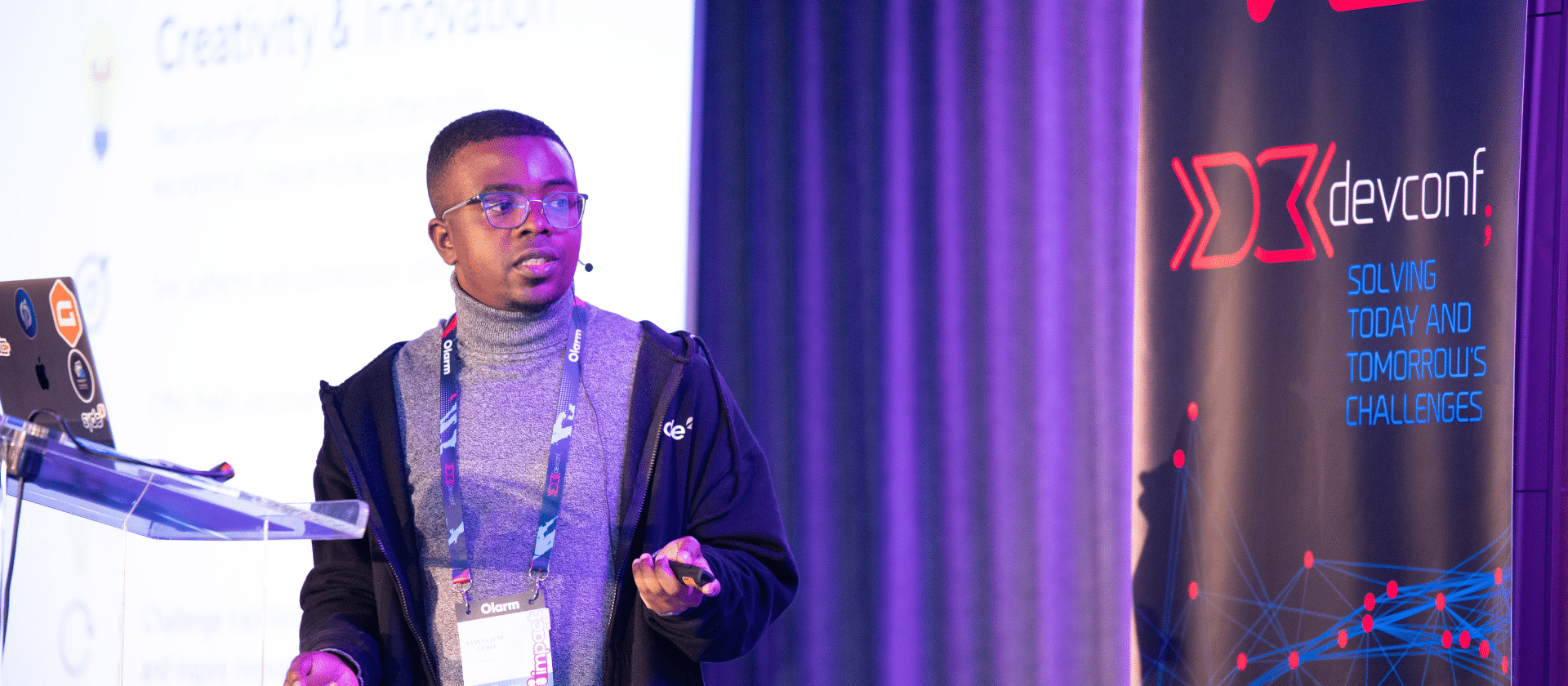Neurodivergent people make up an estimated 15–20% of the global population, which means they’re part of almost every workplace, whether you realize it or not. Yet, so many are expected to adapt to systems that don’t consider how they process, communicate, or thrive. If we want to build teams that are truly inclusive, neurodiversity has to be part of the conversation.
This is a topic I am very passionate about, and back in May, I had the opportunity to speak at DevConf ZA 2025 in Johannesburg and Cape Town. My talk was called “Bridging the Gap: Collaborating with Neurodivergent Colleagues,” and honestly, the response blew me away. The room was buzzing with curiosity and compassion. People weren’t just nodding along; they were asking questions, sharing personal stories, and really engaging. What started as a presentation turned into an ongoing dialogue that continued in the hallways long after the session ended.
This blog post is a reflection of the key ideas from that talk: what neurodiversity really means, why it matters, and how we can all do better to support our neurodivergent teammates. Because at the end of the day, inclusion doesn’t work if it’s not for everyone.

What Is Neurodiversity?
Neurodiversity refers to the natural differences in how human brains are wired. This includes conditions like ADHD, autism spectrum disorder, dyslexia, dyspraxia, OCD, Tourette’s syndrome, and others. These are not flaws or impairments, but variations in cognitive functioning.
As mentioned above, an estimated 15–20% of the global population is neurodivergent. This means that in nearly every workplace, neurodivergent individuals are already present, yet only 37% feel their organization provides meaningful support or recognition. This gap highlights how traditional systems often fail to accommodate different cognitive styles.
As awareness of neurodiversity has grown, so too has the understanding that we need to move beyond a deficit-based model in which neurodivergent individuals are viewed as “less than” or “broken.” Rather than asking how to fix them, we should ask how to design workplaces that support and celebrate different ways of thinking and working.
It’s important to recognize that neurodivergence is often invisible. Many of your colleagues may be neurodivergent without your knowledge. In fact, a recent study found that up to 31% of neurodivergent employees do not feel comfortable disclosing their status, even to their managers. That’s why inclusive practices should not depend on disclosure, they should be embedded into workplace culture by default, ensuring all minds are supported.
The Strengths Neurodivergent Individuals Bring
Neurodivergent people often experience the world differently, and with those differences come valuable strengths. While every person is unique, some common traits include:
- Hyperfocus: Intense concentration on tasks of deep interest, often resulting in high-quality, detailed work
- Creative problem-solving: Many neurodivergent individuals approach problems in unconventional ways, offering innovative solutions others may not consider
- Pattern recognition: The ability to quickly spot connections, trends, or inefficiencies, particularly common in autistic or ADHD individuals
- Emotional intelligence: Especially strong in those who have learned to navigate complex social environments
- Resilience: A lifetime of adapting to systems that do not accommodate you often builds self-advocacy and strength
When supported appropriately, neurodivergent individuals can thrive in roles that match their strengths. In fact, reports found that neurodiverse teams are 30% more productive when given structured support and flexibility. Those strengths often lead to better products, more inclusive teams, and higher-performing companies.
The Challenges Neurodivergent Employees Face
Despite these strengths, neurodivergent individuals often face barriers in the workplace. These challenges are not personal flaws, but the result of work environments that were not designed with cognitive diversity in mind.
1. Sensory Overload
Open-plan offices, noisy environments, harsh lighting, or strong smells can be overwhelming for people with sensory sensitivities. Even digital input, like too many Slack messages or constant video calls, can be exhausting.
2. Executive Dysfunction
This can affect planning, time management, task initiation, or organization. It is not laziness, but a neurological difficulty in transitioning from intention to action, often made worse by stress or unclear expectations.
3. Communication Gaps
Neurodivergent people may interpret communication differently or prefer written over verbal formats. What seems like a lack of engagement might simply be a different style of processing or responding.
4. Masking and Burnout
To fit in, many neurodivergent employees suppress traits such as stimming or avoid natural behaviors to blend in. This constant effort to appear “normal” is exhausting and often leads to burnout.
5. Stigma and Misunderstanding
A 2024 study found that 63% of neurodivergent employees hid their condition from their teammates for fear of stigma. Without disclosure, meaningful support becomes even harder to access.
Inclusion isn’t just about making space, it’s about recognizing that the space already includes us.
– Samuel ‘Fẹ́mi’ Taiwo
How Companies Can Build Neuroinclusive Workplaces
The good news is that you do not need to overhaul everything to support neurodivergent colleagues. Small, thoughtful changes can make a big difference.
- Normalize Flexibility
- Allow flexible hours and remote work when possible
- Provide task instructions in multiple formats
- Respect different working styles, some people need structure, while others thrive on autonomy
- Improve Communication Practices
- Use clear, direct language
- Follow up verbal instructions with written summaries
- Limit unnecessary meetings and embrace asynchronous communication
- Design for Neurodiversity by Default
- Offer quiet spaces or noise-canceling options
- Let people customize their workspace
- Focus feedback on strengths and growth, not just shortcomings
- Create Psychological Safety
- Make it safe for employees to ask for accommodations
- Train managers on neurodiversity and inclusive leadership
- Build a culture where people do not have to disclose personal details just to get support
- Listen to Lived Experience
- Believe people when they tell you what they need
- Include neurodivergent voices in shaping workplace culture and policies
As someone living with AuDHD, OCD, and epilepsy, I have experienced both the relief of working in inclusive environments and the frustration of navigating spaces that were not designed for people like me. This topic is personal to me, but it is also relevant to many others, whether they have a diagnosis or not.
Neurodivergent colleagues don’t need to be fixed. They need to be understood, supported, and valued for who they are. Inclusion isn’t just about making space, it’s about recognizing that the space already includes us.
When workplaces embrace neurodiversity through action, not just intention, we create teams that are stronger, more innovative, and more human.
This talk wouldn’t have been possible without the support of my team at Syde. I’m grateful to work with people who truly value inclusion and actively encourage open dialogue about how we can better support every kind of mind in the workplace.
Start the dialogue at your workplace.
Share this post with your team and spark conversations about how your workplace can become more inclusive of all minds. Change begins with awareness, and it grows through open, honest discussion.
Trusted Resources on Neurodiversity
While the internet and social media can offer useful insights, it’s also a space where misinformation spreads easily. Below are some reliable places to begin your learning journey:
Neurodiversity (General)
- Neurodiversity Wiki – A collaborative, well-curated resource covering a range of neurodivergent conditions.
- NeuroClastic – Features articles and personal stories from neurodivergent writers, with a strong focus on advocacy and awareness.
ADHD
- ADDitude Magazine – A comprehensive platform offering expert articles, webinars, and practical tools for people of all ages with ADHD.
- CHADD (Children and Adults with Attention-Deficit/Hyperactivity Disorder) – A leading nonprofit offering evidence-based information, support groups, and advocacy.
- ADHD Foundation – One of the largest user-led organizations in Europe, supporting people with ADHD and other neurodevelopmental differences including autism, dyslexia, dyspraxia, OCD, and Tourette’s.
- How to ADHD (YouTube) – A well-loved channel known for its accessible, research-informed videos on managing ADHD with compassion and humor.
Autism
- Autistic Self Advocacy Network (ASAN) – A nonprofit led by autistic individuals, promoting equal rights and inclusive policies.
- The National Autistic Society (UK) – Offers practical advice, toolkits, and advocacy for individuals and families.
- Autistica – A UK-based organization focused on scientific research and improving long-term outcomes for autistic people.
Instagram Accounts Worth Following
Here are a few Instagram accounts that provide insightful perspectives and practical advice:
- @adhd_chatter_podcast – Clips and conversations from a podcast featuring ADHD-related discussions.
- @adhdvision – Infographics, tips, and education on living with ADHD.
- @hidden20podcast – Shares lived experiences and promotes awareness from a neurodivergent lens.
- @adhd_love_ – A couple candidly sharing what it’s like to navigate life and relationships with ADHD.
Interested in working at Syde?

Additional articles
-

Rethinking WordPress Multisite: Simpler, Smarter, More User-Friendly
When WordPress 3.0 was released back in 2010, named Thelonious after jazz pianist Thelonious Monk, it introduced a feature that fascinated me immediately: Multisite.
-

Contributing to Something Bigger: My Hacktoberfest Experience at Syde
Hacktoberfest has become a recurring highlight in my year and a moment that reminds me why I am committed to open source and why I enjoy being part of Syde.
